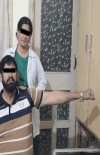Comparative effects of gong's mobilization and mobilization with movement in patients with adhesive capsulitis: a randomized clinical trial
- PMID: 39905175
- PMCID: PMC11794845
- DOI: 10.1038/s41598-025-88422-5
Comparative effects of gong's mobilization and mobilization with movement in patients with adhesive capsulitis: a randomized clinical trial
Abstract
Adhesive Capsulitis results in a progressive contraction of the Glenohumeral joint capsule limiting active and passive range of motion, leading to functional disabilities. Joint mobilization plays a key role in the physical therapy treatment of Adhesive Capsulitis. A relatively new technique, Gong's Mobilization, has been introduced for the treatment of Adhesive Capsulitis. It is focused on the correction of positional faults through controlled dynamic motion of the Glenohumeral joint. The mainstay of this clinical trial is a comprehensive comparative evaluation of MWM with Gong's Mobilization as it remains insufficiently explored. The objective of this clinical trial was to compare the effects of Gong's Mobilization and Mobilization with Movement on pain, range of motion and functional disability in patients with Adhesive Capsulitis. In this triple blinded randomized clinical trial, sixty patients of Adhesive Capsulitis were enrolled within group A (Gong's Mobilization) and group B (Mobilization with Movement). The treatment protocol covered 12 treatment sessions for 4 weeks. Numeric Pain Rating Scale (NPRS), Goniometer, and Urdu version of Shoulder Pain and Disability Index (U-SPADI) were used to assess the pain, range of motion and functional status respectively. These outcome measures were assessed at baseline, after 6 treatment sessions (2 weeks) and conclusively after 12 treatment sessions (4 weeks). For data analysis, within the group differences were measured by Repeated Measure ANOVA and across the group differences were measured by independent t test. A significant difference within the mean values of baseline, week 2 and week 4 NPRS, ROM, and SPADI score was observed in both study groups (p < 0.001). Results of independent t test used to calculate across the group differences indicated that Gong's Mobilization was more effective in reducing disability (SPADI)(p < 0.001) and improving ROM(p < 0.001), meanwhile both groups were equally effective in reducing NPRS scores(p = 0.78). Moreover, a medium to large effect size was also observed for all the outcomes, pain(d = 0.5), ROM (d = 0.5-2.7), SPADI(d = 0.5). It was concluded that Gong's Mobilization is more effective than Movement with Mobilization. Following four weeks of treatment, it pronounced statistically significant and clinically relevant results in improving pain, ROM and functional status of patients with Adhesive Capsulitis. Trial Registration Trial was registered in IRCT (Trial registration number: IRCT20190717044238N4 Trial Registration Date: 01-03-2023).
Keywords: Frozen Shoulder; Manual therapy; Physical therapy techniques; Rehabilitation.
© 2025. The Author(s).
Conflict of interest statement
Declarations. Competing interests: The authors declare no competing interests. Ethics approval and consent to participate: This study was approved by the Institutional Review Board of the Riphah International University, Lahore, Pakistan. (REC/RCR& AHS/23/0104, Dated: 02/01/2023). The clinical trial was prospectively registered in the WHO‑Iranian registry of clinical trials (Trial registration number: IRCT20190717044238N4 Trial Registration Date: 03-01-2023). This study is a part of my research project for Masters in Orthopedic Manual Therapy. All the participants provided informed written consent before taking part in the study. All methods were carried out in accordance with the relevant guidelines and regulations. Consent for publication: Informed consent was obtained from the participants and/or their legal guardians to publish identifying information/images in an online open access publication.
Figures










Similar articles
-
Does Integration of Graded Motor Imagery Training Augment the Efficacy of a Multimodal Physiotherapy Program for Patients With Frozen Shoulder? A Randomized Controlled Trial.Clin Orthop Relat Res. 2025 Apr 1;483(4):707-716. doi: 10.1097/CORR.0000000000003252. Epub 2024 Sep 17. Clin Orthop Relat Res. 2025. PMID: 39436270 Clinical Trial.
-
Comparison of intra-articular ozone and steroid injection in patients with adhesive capsulitis.Clin Rheumatol. 2025 Jun;44(6):2517-2525. doi: 10.1007/s10067-025-07471-3. Epub 2025 May 9. Clin Rheumatol. 2025. PMID: 40343617 Clinical Trial.
-
Efficacy of MRI and clinical findings of Lidocaine injection combined with manual therapy in frozen shoulder-A prospective, randomized, single-blinded, sham-controlled trial.PLoS One. 2025 Aug 6;20(8):e0328783. doi: 10.1371/journal.pone.0328783. eCollection 2025. PLoS One. 2025. PMID: 40768512 Free PMC article. Clinical Trial.
-
Arthrographic distension for adhesive capsulitis (frozen shoulder).Cochrane Database Syst Rev. 2008 Jan 23;(1):CD007005. doi: 10.1002/14651858.CD007005. Cochrane Database Syst Rev. 2008. PMID: 18254123
-
Efficacy of Different Types of Mobilization Techniques in Patients With Primary Adhesive Capsulitis of the Shoulder: A Systematic Review.Arch Phys Med Rehabil. 2016 May;97(5):815-25. doi: 10.1016/j.apmr.2015.07.025. Epub 2015 Aug 15. Arch Phys Med Rehabil. 2016. PMID: 26284892
References
-
- Carmignano, S. M. Frozen shoulder: symptoms, causes, diagnosis, and treatment. in Shoulder Surgery for RC Pathology, Arthropathy and Tumors (IntechOpen, (2022).
-
- Hassankhani, E. G., Pettersson, H., Hassankhani, S. G. & Hassankhani, G. G. Prevalence of diabetes and its effect on the Course and Treatment of Frozen Shoulder. Open. J. Orthop.12, 463–473 (2022).
Publication types
MeSH terms
Associated data
LinkOut - more resources
Full Text Sources
Medical

